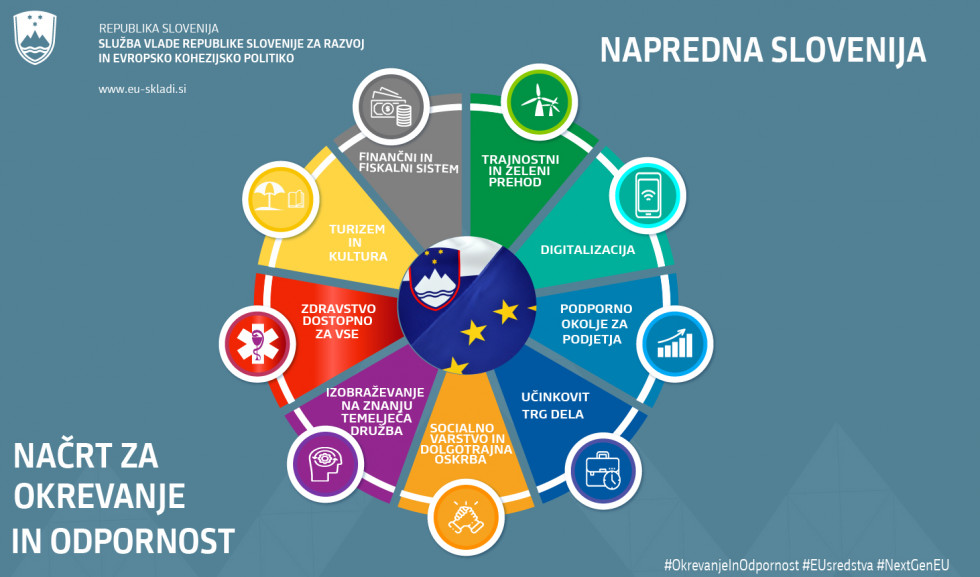National Recovery and Resilience Plan proposal
- Government Office for Development and European Cohesion Policy
On 27 August 2020 the Government of the Republic of Slovenia took note of the bases for developing the national Recovery and Resilience Plan (RRP) which outlined the main priority areas. On 8 October 2020 the Government then approved the draft RRP which was submitted by the Government Office for Development and European Cohesion Policy (GODC) on 19 October 2020 to the European Commission (EC) for informal coordination.
Member States will be able to submit their recovery and resilience plans for formal approval only after the adoption of the Regulation establishing a Recovery and Resilience Facility planned to take place in February 2021.
In November and December 2020, GODC held technical meetings with EC officials for all planned areas of the RRP and consulted with all relevant stakeholders. Over the last four months, the draft RRP has been presented to more than 2,000 stakeholders. On this basis, an amended proposal of the RRP has been prepared, with the areas and financial framework not being subject to significant changes.
Areas
In line with the European Commission guideline, the RRPs shall support long-term reforms and investments, especially in green and digital technologies, having a lasting impact on the productivity and resilience of the economy. The planned investments shall ensure the resilience of the healthcare system and long-term care system, mitigate the socio-economic consequences of the COVID-19 epidemic and support strategic investments supporting green and digital transition.
The upgraded version of the RRP defines nine development areas or priorities that support key objectives, namely the labour market, healthcare system, social protection and long-term care, financial and fiscal system, supportive environment for companies, sustainable and green transition, digital Slovenia, education – knowledge-based society, and tourism and culture. In accordance with the EC instructions of 17 September 2020, each of the abovementioned areas contains the required elements, namely a description of reforms and investments, including funding and costs, challenges and objectives, and the contribution to green and digital transition. Each area is defined with milestones, targets and a timeline for implementation, as well as links and coherence with other EU programmes.
By 2026 Slovenia is eligible up to EUR 5.2 billion for investments under the RRP of which up to EUR 1.6 billion in grants and up to EUR 3.6 billion in refunds. In the coming months, the EC, which manages the Recovery and Resilience Fund centrally, will decide on the reforms and investments, identified in the RRP, approve investments up to the amount of available funds.
Table: Financial framework by areas, 23 December 2020 (in Slovene)
Implementation
The RRP will include the key national strategic projects, while other projects prepared by local communities, companies and other beneficiaries will to the most part be selected through calls for proposals or other measures.
In line with the proposal Regulation establishing a Recovery and Resilience Facility, Member States are required to report annually to the EC on the progress in terms of the RRP implementation, monitor implementation by targets and milestones, and submit payment requests or tranche requests to the EC (in the case of loans). The EC will mobilise funds for individual measures and projects when the set milestones are achieved.
National RRPs will be the source of extensive financial support for investment in reforms and structural change based on green and digital transition. The purpose of the RRPs is to help Member States address the challenges identified in the European Semester recommendations in areas such as competitiveness, productivity, environmental sustainability, education and skills, health, employment and economic, social and territorial cohesion. RRPs will contribute to job creation, sustainable growth and improve the resilience of Member States. The EC should listen to the different needs of the Member States who know best which sectors and areas have been most affected and which measures will most effectively help them in the recovery and ensuring resilience process.
The Government also instructed and authorised GODC and the relevant ministries to start implementing the React-EU initiative before its formal approval by the EC, which is expected to happen by the end of March 2021. Under the React-EU initiative, Slovenia is eligible to EUR 330 million by 31 December 2023 (currently EUR 262 million is approved).


